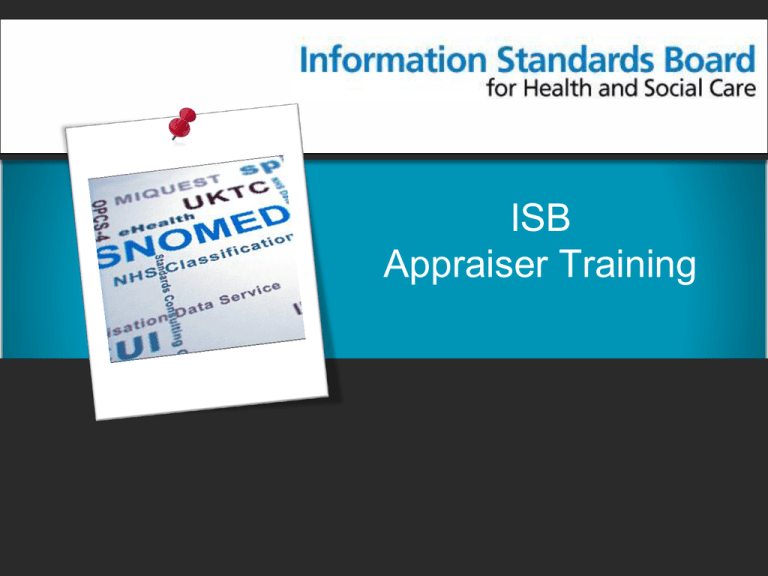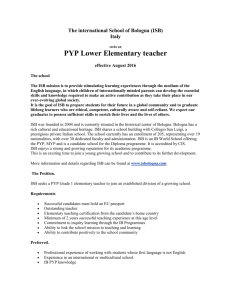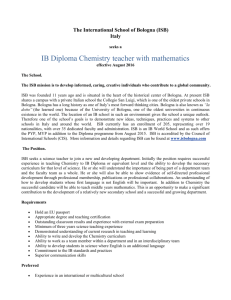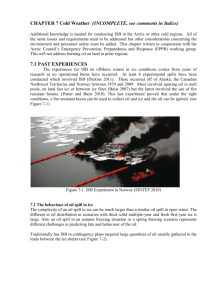Appraiser Training - Information Standards Board for Health and
advertisement

ISB Appraiser Training Contents • Information Standards Board • Development methodology • Appraisal process • Conducting an appraisal • Further information Information Standards Board The Information Standards Board for Health and Social Care in England (ISB) is tasked with the independent approval, assurance and governance of information standards for adoption by the NHS and Adult Social Care. The scope of ISB includes all information standards within the DH, NHS and Adult Social Care. This scope extends to those required to support approved sharing and communication with other agencies where NHS infrastructure and systems are used. The ISB: Ensures that information standards are fit for purpose, can be implemented, support the exchange of information between systems, such that sending and receiving people derive the same meanings, and reduce clinical risk, while ensuring stability or improvements in patient safety. Reviews DH, NHS and Social Care information standards to ensure that they are still appropriate and consistent (including those approved by its predecessor, CRIR - the Committee for Regulation of Information Requirements). Identifies the need for future standards and, where necessary, the development of additions or subtractions to existing DH, NHS and Social Care standards. This may include producing a case for change. Provides input into policy implications for information standards and into informatics policy itself to ensure it can be delivered by the informatics community, i.e. ISB will express the burden that policy decisions may have to support the decision making process. Undertakes from time to time a review of the scope of the ISB remit in the light of changes to service delivery, e.g. the establishment of care trusts. What is an Information Standard? An information standard is a formal document approved and issued by the Information Standards Board for health and social care. It defines technical criteria, content, methods, processes and practices for mandatory implementation across health and social care in England. Clinical Information Standards Clinical information standards build upon existing national clinical practice, ideally set down by a national body such as the National Institute of Health and Clinical Excellence (NICE). The benefits are clear. If every clinician is expected to record information in a specified way then all IT systems should accept it in this format. Example of clinical information standards are data sets used for record-keeping or information standards underpinning National Patient Safety Agency safer practice notices. Social Care Information Standards Social care has information requirements distinctly different from health. Strictly speaking the ISB covers adult social care, with the childrens' social care being managed by the Department of Education. In practice, setting social care information standards is a new area for the ISB. More work is required to deliver concrete examples of whether standards can deliver in this area. Secondary Uses Information Standards Secondary uses describes the use of patient data outside that of delivering direct care. This could be for the management and audit of the Trust or the NHS as a whole; medical research or public health protection. National secondary uses requires that Trusts provide data in a common format in a specified way. This makes them ideal candidates for information standards. Examples include the information standards underpinning commissioning and the National Service Frameworks. Development Methodology Developing an information standard normally takes between 9 and 12 months. Implementation can take 1 – 3 years. The assurance and approval by the ISB is conducted alongside this. Due to the investment required it is only suitable where the scope of the change will occur nationally and where there is a clear consensus on how to achieve the change. Developing an information standard involves: Identifying the business need and agreeing it with those impacted by the information standard. This is normally underpinned by a business case. Developing a precise definition of what is required in order that there is no ambiguity or confusion. This includes considering information governance, how it is to be implemented, burden and clinical safety. Testing the information standard to ensure that it works as expected. Implementing the information standard into health and social care and then maintaining it until it is no longer required. Managing the retirement of the information standard. Approval of the information standard by the information standards board for health and social care (ISB) unfortunately does not remove the need to manage its implementation. The development methodology is hosted on the ISB website. Development Stages The development of each information standard will normally be managed through the following stages: Need – an information deficit or gap within the existing national or international portfolio or product suite that is planned to be remedied by the proposed development. Requirement – the requirements for the information standard are identified. Draft – the technology elements of the standard are defined and assured. Development testing has identified any technical issues and mitigations are in place. Full – there is evidence that the standard is implementable, interoperable and safe and is supported by an ongoing maintenance and update process. This is normally gathered through implementation testing or pilot. Implementation – the information standard is being implemented in health and social care. Maintenance – the information standard is used in operation. Retirement – the standard is deprecated and then withdrawn. Why do we need a methodology? • • • • Transparency – Everyone needs to understand the rules of the game. This stops surprises. Choice – There are other ways of implementing change rather than making a new standard. Developers need to understand there is a choice. Learn from mistakes – Many people have developed information standards. It is right that we learn from their mistakes to make the process easier. Increase success / reduce costs & time – Ultimately this is about reducing the costs and time to achieve the goal of the standard. Note that the standard is a means to an end. A great example is reducing the cost of change. The cost of change rises considerably throughout the lifecycle. It is therefore absolutely key that the feedback from the ISB is prompt, relevant and early enough to allow it to be implemented without significant cost. Appraisal Process Quality criteria Fit for purpose Risks and issues Appraisal Each information standard goes through a rigorous appraisal process based on the identification of risks and issues. The standard is appraised by subject matter experts (known as appraisers) recruited from the NHS and supplier communities. It is led through the process by a domain lead and standards manager to ensure that the process is as seamless as possible. The aim of the appraisal process is to ensure that all risks and issues are identified; and then resolved or mitigated such that an information standard meets the ISB quality criteria for approval. The acceptance and management of risks and issues by the sponsor and developer of the standard is critical to an information standard being approved by ISB. Standard Quality Criteria Any standards must meet the following criteria. The appraisal process ensures that their is evidence that the criteria are met: • • • • • • • • • • Is within the legal and information governance framework of the DH and NHS National (England) in scope. Fit for purpose. Of overall benefit to health and social care particularly for health IT. Capable of being implemented in organisations and health IT systems (where appropriate). Supports interoperability between machines (functional) and people (semantic). Compatible with existing standards, professional practice and DH policy. Clinically and organisationally safe. Does not impose an unanticipated cost burden on organisations. Approved by a sponsor who commits that: • A strategic outline case exists for the business change proposed by the standard. This will normally have been approved by the Informatics Professional Network Group (IPNG). • The prospective information standard has a defined purpose and scope. • There is sufficient funding and resources allocated to complete the development, implementation and maintenance of the standard within health and social care. Examples of Quality Criteria Product • Individual product quality criteria. These are given as part of the product descriptions in the method. For example, a quality criteria for the Statement of Need product is "There is a clear, measurable need for the information standard where benefits outweigh cost plus risk." Stage • The appraisal criteria for the stage. For example, one of the Requirements stage quality criteria is "The requirements for the information standard are clearly understood with no ambiguity and accepted by the stakeholders. They meet the identified need and are consistent with the stated purpose and scope." Standard • An overarching set of standards quality criteria. An example is that the standard must be "Of overall benefit to health and social care particularly for health IT." Appraisal Roles Domain Lead The domain lead is an ISB board member responsible for the strategic development of a specific area of information standards. They bring a broad understanding of health and social care and a national reputation and network of contacts in a specific domain area. The domain lead manages the assurance of prospective and approved information standards from proposal through to implementation, maintenance and retirement. They manage the resolution of significant issues identified during the appraisal process, including briefing the ISB as required. Appraiser The appraiser is a subject matter expert in a specific area impacted by an information standard. They are independent of the ISB. Their purpose is to ensure that the prospective information standard is fit for purpose for the NHS and social care based upon the ISB quality criteria. Appraisers give constructive, structured advice to the developers of standards in line with ISB guidance. The advice explains how to improve their standard submissions to meet the standards criteria along with any associated implementation and user guidance. Information Standards Manager The information standards manager is responsible for co-ordinating the assurance of information standards through a process of formal appraisal including the proposals for implementation, maintenance and retirement. In general, the output of this process will result in a recommendation being made to the Information Standards Board for that standard. What Makes a Good Appraiser? Follows the development methodology Understands risk and issue management Can see the big picture and the details together Identifies quality defects and problems and suggests solutions Clearly communicates back to the developer Provides feedback promptly Respects all involved in standards development Conducting an Appraisal Read • Check the products have been provided • Read the submission from cover to cover Review • Identify any general risks and issues • Check each product meets the quality criteria • Consider if the standard is sensible, fit for purpose and useful Respond • Document problems as risks or issues • Record detailed comments on the specification on the comment sheet • Upload to SharePoint and notify Standards Manager Structure of a Submission The appraiser will be provided with the following documents from the developer: •Submission – guidance for the appraisers and ISB on what they are reviewing and why. The overview will be written for the specific submission stage (Requirement / Draft / Full). •Mandatory products – those documents required by ISB for approval of a standard. These are marked with a Y in the ISB column of the product list at each stage •Other supporting products – any other documentation that the ISB will find useful in understanding the standard. •Risks and issues log - this is absolutely crucial to demonstrating that risks are being managed appropriately •Glossary of terms Mandatory products Supporting products Submission Risk and issues logs Glossary of terms Further Information Development Methodology ISB website SharePoint Appraiser Area Don’t Panic ISB mailbox











